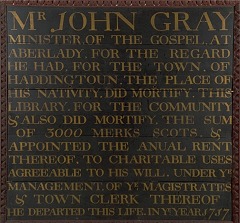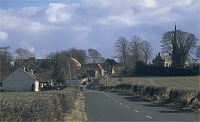Contents ![]() | Introduction
| Introduction ![]() | Institutes of learning
| Institutes of learning ![]()

The earliest public libraries
Page 1 of 2 | Next
'Mr John Gray minister of the gospel at Aberlady, for the regard he had, for the town of Haddingtoun, the place of his nativity, did mortify, this library for the community & also did mortify, the sum of 3,000 merks Scots & appointed the annual rent thereof, to charitable uses agreeable to his will, under Ye management, of Ye Magistrates & Town Clerk thereof. He departed this life in Ye year 1717'.
So began Haddington Public Library. By this gift John Gray was the father of public libraries in East Lothian, if not Scotland. A room in the old Grammar School was used as the lending library. It was still there 150 years later, by then part of the town and country library. Periodic indexing and purchases kept the collection serviceable. Remarkably, over 900 of Gray's own books were still among 1500 old volumes given to the safekeeping of the National Library of Scotland in 1983.
Gray's model for his act of benevolence was probably that of Bishop Burnet, who in 1715 had left 20,000 merks to nearby Saltoun parish. Burnet's Trust provided for local education, the upkeep of the poor and the 'increase of the library of the minister's house and use'. Burnet meant to educate his successors; Gray wanted to benefit everyone in Haddington.

The Saltoun library began in 1657 with 139 books for the use of the minister. Norman Leslie, another minister, had left them; he had taught the sons of the Laird of Saltoun. Burnet added 10 books when he was minister there (1665-1669). Around 2000 books were in the library when it was deposited in the National Library of Scotland in 1977.
Both of these collections are important for the history of libraries in the Lothians and Fife. When they were founded there were few other libraries. There were some school and university collections or other special libraries, like the Advocates Library and the Library of the Royal College of Physicians in Edinburgh. The well to do and upper classes had private libraries. But in the 18th century a host of new libraries appeared. There were two driving forces - religion and enlightenment - and three patterns - parochial, circulation and subscription.
Page 1 of 2 | Next
Contents ![]() | Introduction
| Introduction ![]() | Institutes of learning
| Institutes of learning ![]()